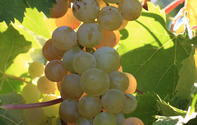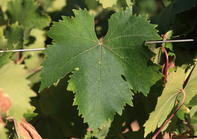Description
Grenache Blanc is a white wine grape that originated in northern Spain from where it spread to France to become the fourth most planted vine in France. Grenache Blanc is well-known for its role in the Chateauneuf-du-Pape blend. It is a white mutation of Grenache Noir and produces full-bodied high alcohol white wines.Origins
SpainOther Names
Grenache Blanc has many names - over 20 synonyms - depending on where it is grown. Grenache Blanc is also known as Alicante Blanca and Garnatxa Blanca (in Catalonia).Production in South Africa
The first Grenache Blanc in South Africa was established in the early 1900s on the farm Delheim near Stellenbosch but was only commercially introduced in 1979 when it was regarded as an ‘interesting’ newcomer.Production Regions
Plantings of Grenache Blanc seems to be increasing with about 20ha (of the 110ha total plantings) established in 2016. Of the newly planted 20ha, 10 hectares were established in the Cape South Coast region. Grenache Blanc can be found in all the wine regions except the Northern Cape. Notable producers of 100% Grenache Blanc wines include KWV, Paardeberg and Leeuwenkuil.Growth and Ripening
Grenache Blanc is a heavy bearer (15-20ton/ha) and vigorous grower, but overproduction may lead to flabbiness (low acidity) in its wines. Thinning of bunches is recommended. Although drought resistant, it can struggle to achieve good acidity in hot and dry climates. An upright grower that is wind-resistant, Grenache Blanc does well in dry areas on poor rocky or sandy soils. It can be grown as bush vines or on a smaller trellis system. Grenache Blanc requires a long warm ripening period and is harvested in the middle of the harvest season.
Leaves and Berries
Grenache Blanc almost kidney-shaped leaves are shiny green and smooth with rectilinear teeth. The yellowish green berries are medium in size and bunches are large and seems almost round in shape. Berry skin is tough with soft and juicy pulp.
Pests and Diseases
Grenache Blanc is highly susceptible to bacterial diseases, grey mould, phomopsis and mildew but is rarely affected by oidium, grapevine ‘grillure’ leaf hoppers and mites. The vine is sensitive to botrytis and if plant material is virus-infected, it is extremely prone to poor setting of fruit, resulting from poor pollination; consequently the grape berry fails to develop.
Use
Grenache Blanc is a popular grape in blends and is used in fortified wines in Spain and France. Producing yellow gold white wines with body and a high alcohol content (13 – 15%) if fermented dry, Grenache Blanc is prone to oxidation and have a limited ageing potential as a single varietal. Blended with other wines can increase its shelf life while acting as a ‘softener’ in a blend. Grenache Blanc is one of the varieties used to make Rivesaltes Vin Doux Naturel, a naturally sweet wine made with added brandy to last over 100 years.Taste/Flavour
‘Richness’ and ‘green fruit’ seem to be two regular descriptions on tasting notes for Grenache Blanc. Other notes include fenugreek (or cumin), citrus and, if the wine was treated with oak, flavours of baked apple and brioche are also noted. Grenache Blanc is appreciated in the United States for its intense flavours, higher alcohol content, and richness - similar to Chardonnay - when matured in oak.
By Marinda Louw
